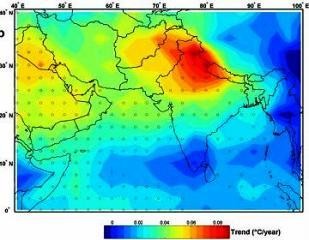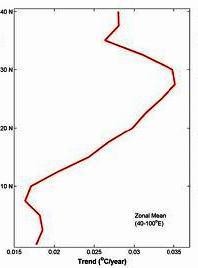Spatial distribution of the mid-tropospheric temperature trend over the Indian Monsoon region in May. 
The temperature of air over western Himalayas had been showing an increasing trend during the last 30 years peaking during the month of May each year, satellite data has revealed. In May 2007, for instance, it was 2.7°C warmer than it was in May 1979.
The warming is most pronounced in the month preceding the onset of monsoon, observes Ritesh Gautam, a research scientist at the University of Maryland in the United States.
His research was funded by US space agency NASA and his team included Christina Hsu, William Lau and Si-Chee Tsay of NASA Goddard Space Flight Center in Greenbelt, Maryland and Menas Kafatos from Chapman University, California.
The rising temperature over western Himalayas and its impact was one of the topics of the International Glaciology Conference that concluded April 10 at Manali in Himachal Pradesh, India, where the results of the team's research1 were presented.
One of the key drivers of the Indian Summer Monsoon is the land-sea thermal gradient from the relatively cooler Indian Ocean to the Himalayas-Tibetan Plateau (HTP) that rises nearly 5 kilometres above sea level. Warm air rising over the landmass — in response to the pre-monsoon heating of the HTP — drives moist air from the ocean towards the continent only to be stopped by the towering Himalayas. This results in heavy rainfall over South Asia that forms the bulk of the annual precipitation during each summer, from June through September.
For their study, the researchers analyzed satellite derived temperatures of the mid layer of the 'troposphere' over the western Himalayan-Gangetic region for the period 1979 to 2007. The troposphere, where the weather is made, is the lowest portion of Earth's atmosphere extending up to 17 kilometres from the surface.
Latitudinal profile of mid-tropospheric temperature trend for the pre-monsoon season (March–April–May) from 1979 to 2007.
The spatial extent of the warming spans the Himalayas to the western arid regions of Pakistan, Afghanistan, Iran and the Arabian Peninsula with appreciable warming also found over the Hindu-Kush Mountains, the researchers said. "Overall, it is found that the entire South Asian monsoon region has experienced tropospheric warming during May since 1979," the scientists report. However, warming is the highest over the western Himalayan region.
"Together with the possible alterations to the monsoon dynamics on seasonal-to-interannual time scales, the observed warming at elevated altitudes, if continues, may also have direct implications to the Himalayan glaciers and snow packs and in turn the hydrological cycle over much of South Asia," the scientists conclude.
The Himalayas contain the largest ice covered regions of the Earth's surface outside the poles and their glaciers form a source of major rivers in South Asia, such as the Indus and the Ganges, that serve about 900 million living in the Indo-Gangetic Plains (IGP) that encompass parts of northern India, Pakistan and Bangladesh.
Will the heating of the troposphere over western Himalayas and the resulting strengthening of the land-sea thermal gradient increase the monsoon rainfall in the coming years?
"Right now we do not want to comment since this is a subject of an ongoing study and will be reported in a separate paper," Gautam told Nature India. He added however that their ongoing work suggests that the enhanced warming in May could cause an increase of water vapor flux over northern India "with strong positive trends" of all India Rainfall in June.
"All that we can say now is that the observed enhancement of troposphere heating may result in the "advancement" of the monsoon rainfall in early summer," he said. "We may see an increase in the early monsoon rainfall."
